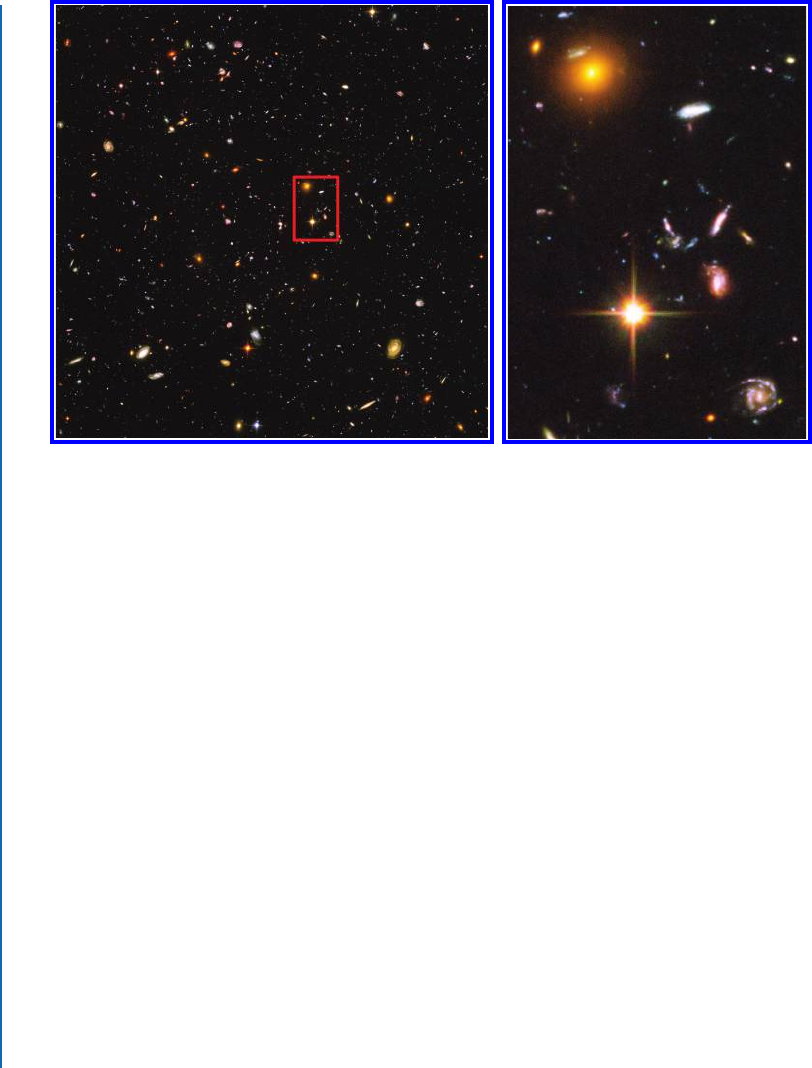
2.9. THE DEEP FIELD 53
Figure 2.20: A scale model on cash register tape. e Milky Way is at one end, and the galaxy
LEDA 20221, 330 Mpc away, is near the other end of the 40-m long tape. At this scale, a giant
elliptical galaxy such as M 87 just fits across the tape’s 40-mm width. (Photograph by the author.)
2.9 THE DEEP FIELD
e Hubble Ultra Deep Field (UDF) is a photo montage taken with the Hubble Space Tele-
scope; see Figure 2.21. Nearly every one of the many thousands of objects on the image is a
distant galaxy. Only a few of the objects are nearby stars within our own Milky Way; they are
easily identified by the cross-like diffraction spikes created by the secondary mirror supports
within the telescope.
e UDF covers a very tiny piece of the sky—only a few arcminutes wide—essentially
peering between the stars in our own Milky Way. e most distant objects visible in the image
are estimated to be nearly 4,000 Mpc (13 billion light years) away, and so the UDF show us a
part of the universe less than one billion years after the Big Bang (see Part II of e Big Picture).
2.10 THE END OF SPACE
We see back in time when we look out into space. And so if there was a time before which there
was nothing to see, it follows that there is a maximum distance that we can see in space. In
Section 5.4.2 we will consider the Big Bang—the notion that the universe was once extremely
hot and dense, and has been expanding and cooling since. Early in the Big Bang, the entire
universe—although full of photons of light—was opaque to their uninterrupted passage through

54 2. LOOKING OUTWARD
Figure 2.21: e Hubble Ultra Deep Field. e enlarged detail on the right is of the area boxed in
red in the full image on the left. Only a few Milky Way stars show in the full image, identifiable
by the cross-like diffraction pattern (from the secondary mirror support within the telescope)
they display. e other „10,000 objects in the image are galaxies. (Image credit: NASA, ESA,
and S. Beckwith (STScI) and the HUDF Team, Public Domain.)
space. And so we can look back no further than to the time, over 13 billion years ago, when the
universe first became transparent.
e light from that epoch of recombination is called the cosmic microwave background, and
it tells us what the universe was doing about 13.5 billion years ago, when all of everything was
still too hot to touch. is cosmic microwave background (CMB) can be seen in every direction
with microwave telescopes. Figure 2.22 shows a map of the CMB covering the entire sky, from
the Wilkinson Microwave Anisotropy Project.
e CMB is important because it shows us the beginnings of large-scale structure in the
universe. And this structure—concentrations of mass held together by gravity—is responsible
for all that we know, ourselves included. We consider this topic further in the last chapter of e
Big Picture.
2.10.1 THE COSMOLOGICAL HORIZON
And so how far away is the CMB? ere is no simple answer; indeed the question itself is more
complex than one might think. If the Big Bang occurred 13.8 billion years ago, then one might
expect that we can see objects no more distant than 13.8 billion light years away—the distance
..................Content has been hidden....................
You can't read the all page of ebook, please click here login for view all page.
